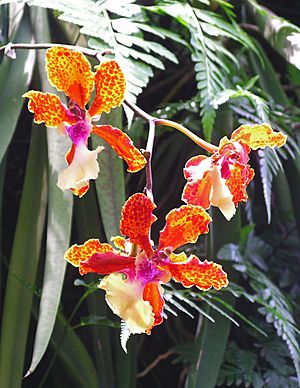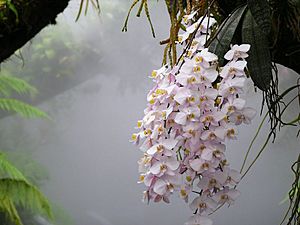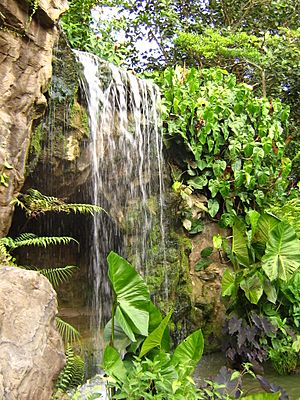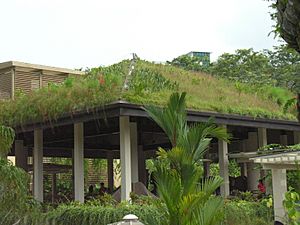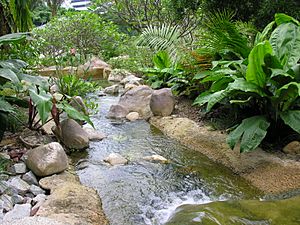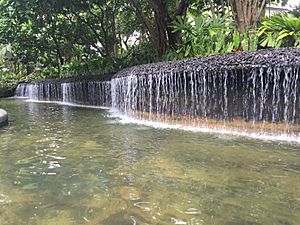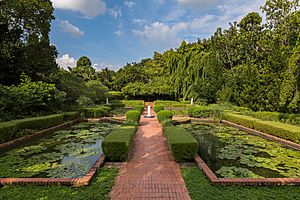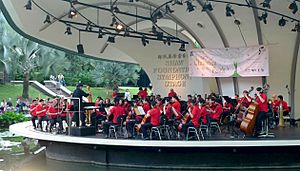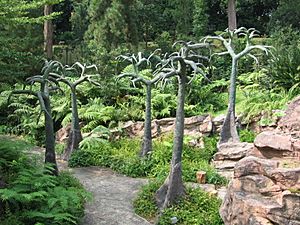Singapore Botanic Gardens facts for kids
Quick facts for kids Singapore Botanic Gardens |
|
|---|---|
| Kebun Bunga Singapura (Malay) 新加坡植物园 (Chinese) சிங்கப்பூர் தாவரவியல் பூங்கா (Tamil) |
|
 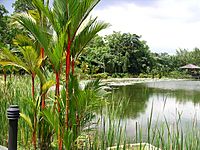
Symphony Lake
|
|
| Location | Tanglin, Central Region, Singapore |
| Area | 82 hectares (202.63 acres) |
| Created | 1859 |
| Operated by | NParks |
| Public transit access | CC19 DT9 Botanic Gardens (Bukit Timah Gate) TE12 Napier (Tanglin Gate) |
| UNESCO World Heritage Site | |
| Criteria | Cultural: ii, iv |
| Inscription | 2015 (39th Session) |
| Area | 49 ha |
| Buffer zone | 137 ha |
The Singapore Botanic Gardens is a very old tropical garden in Singapore. It is located near the famous Orchard Road shopping area. This garden is special because it is one of only three gardens in the world, and the only tropical one, to be named a World Heritage Site by UNESCO.
Since 2013, it has been voted Asia's best park by TripAdvisor. In 2012, it was even named the "Garden of the Year" by the International Garden Tourism Awards.
The Botanic Gardens first opened in 1859. It played a huge part in the rubber industry in the early 1900s. A scientist named Henry Nicholas Ridley found a better way to collect rubber from trees. He also showed farmers how valuable rubber could be. This helped rubber production grow very fast. By the 1920s, the Malayan peninsula (which includes Singapore) made half of the world's rubber!
Inside the main gardens, you'll find the National Orchid Garden. This garden is a leader in studying orchids and creating new types (called hybrids). Singapore is a big exporter of cut orchids. Thanks to Singapore's warm, wet weather, the garden has the largest collection of orchids. It has 1,200 different types and 2,000 hybrids.
When Singapore became an independent country, the Botanic Gardens helped turn the island into a "Garden City." This is a nickname Singapore is still known for today. In 1981, a special orchid called Vanda Miss Joaquim became Singapore's national flower. The Gardens also practice "orchid diplomacy." This means they name beautiful new orchids after important visitors like world leaders and celebrities. These special orchids are shown in the VIP Orchid Gardens.
The Gardens are open every day from 5 AM to midnight. Entry is free, except for the National Orchid Garden. There are over 10,000 types of plants in the garden. It covers an area of 82 hectares (200 acres). The garden is quite long, stretching about 2.5 km (1.6 mi) from one end to the other. About 4.5 million people visit the Botanic Gardens each year.
History of the Gardens
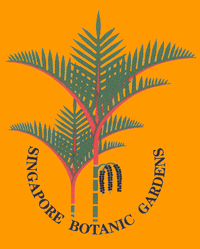
The very first "Botanical and Experimental Garden" in Singapore was started in 1822. It was created by Sir Stamford Raffles, who founded modern Singapore. He was very interested in nature. This first garden aimed to find plants that could be important for the economy. This included fruits, vegetables, spices, and other raw materials. However, this first garden closed in 1829.
Thirty years later, in 1859, the current Singapore Botanic Gardens began. The Singapore Agri-horticultural Society was given 32 hectares of land. This land was in an area called Tanglin.
Early Years (1859–1876)
At first, the new gardens were mostly a "pleasure park" for the society's members. Lawrence Niven was hired to design the park. He turned old plantations and wild rainforest into a beautiful public park. He designed the Gardens in the style of English parks. This included paths, open areas for music, and pretty plants. The way the Gardens look today is still mostly based on Niven's design.
In 1866, the Gardens grew by about 12 hectares. Swan Lake was also dug in 1866. In 1868, Burkill Hall was finished. The Agri-horticultural Society ran out of money, so the government took over the Gardens in 1874. In 1875, Henry James Murton became the first Superintendent of Gardens. A zoology expert, William Krohn, also started a collection of animals. This created Singapore's first zoo within the gardens. By 1877, the zoo had about 150 animals.
Rubber and Orchid Discoveries (1877–1942)
The first rubber tree seedlings arrived at the Gardens from Kew Gardens in 1877. Henry Nicholas Ridley, a naturalist, became the director in 1888. He was sometimes called "Mad Ridley" because he was so passionate about rubber. He led the way in growing rubber. Ridley's experiments with rubber planting were very successful. He convinced farmers across Malaya to use his methods. The results were amazing! Malaya became the world's top producer of natural rubber.
In 1879, the Palm Valley was created. Nathaniel Cantley became the second Superintendent in 1880. He oversaw the building of Ridley Hall in 1882. Other new areas included the Plant House and plant nurseries. Because the zoo was expensive to run, the government closed it in 1903. All the animals were sold.
Later, E.J.H Corner House was built in 1910 and Holttum Hall in 1921. During this time, Singapore's national flower, the Vanda Miss Joaquim orchid, was found. This was part of the amazing work by Professor Richard Eric Holttum. He was the Gardens' director from 1925 to 1949. His new ways of creating orchid hybrids made Singapore a world leader in growing orchids. Today, the Gardens have the largest collection of tropical plants.
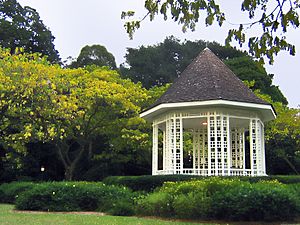
During World War II (1942–1945)
During the Japanese occupation of Singapore (1942-1945), a geology professor named Hidezo Tanakadate helped protect the Gardens. He worried they might be damaged. He spoke directly with General Tomoyuki Yamashita to take control of the Gardens. He made sure no looting happened. The Gardens continued to work as a science center. The directors, Holttum and Edred John Henry Corner, were kept at the Gardens. They were told to keep working on plants.
The Japanese government did not give money to the Gardens. So, Tanakadate paid for staff and upkeep himself. The Gardens were renamed Shōnan Botanic Gardens. Tanakadate returned to Japan in 1943. Dr. Kwan Koriba, a botany professor, became the new director. He stayed until the war ended.
After the War (1945–1986)
After the war, the British took back control in September 1945. Koriba was made a prisoner of war. Corner helped get Koriba released. He explained that Koriba had protected the Gardens. Koriba chose to stay with his countrymen until his release in 1946.
Murray Ross Henderson became director from 1949 to 1954. Later, the Gardens played a key role in Singapore's "greening" efforts. This was part of the "Garden City" campaign in the early years of Singapore's independence.
Modern Era (1986–present)
In 1986, the Singapore Botanic Gardens came under the care of the National Parks Board. The Gardens were improved with new facilities for visitors, research, and training. Today, the Gardens focus on the "Garden City Vision." They also focus on growing plants, studying plants and animals, and providing recreation and education.
In 2009, a "Tyersall extension" was announced. This added 18 hectares of land, making the Gardens almost four times bigger than when they started. This new area is called the Gardens' Learning Forest. It was finished in 2018. The Learning Forest has a center for learning about forest conservation. It also has a Natural History Art Gallery in old colonial buildings.
The Learning Forest shows off the best tropical trees that grow in Singapore. It helps the Botanic Gardens be a top place for research and education. Visitors can see unique trees and plants on different walks. There are giant trees, trees with interesting bark, and a bamboo garden. This area also helps prevent floods in the Orchard Road shopping district. It has a pond that can hold a lot of rainwater.
Attractions to Explore
The garden is surrounded by different roads. The main entrance, Tanglin Gate, faces Holland Road in the south. The garden is about 2.5 km (1.6 mi) long from north to south. There are many entrances to different parts of the Gardens.
National Orchid Garden
The National Orchid Garden is the most popular part of the Botanic Gardens. It is a hilly area of three hectares. It has over 1,000 types of orchids and 2,000 orchid hybrids.
Here are some special places within the Orchid Garden:
- Burkill Hall: This is an old colonial house built in 1886. It used to be where the garden director lived. It's named after a father and son, Isaac and Humphrey Burkill, who were both directors. The first floor is now an exhibition area. It shows information about the different orchids named after important visitors.
- VIP Orchid Garden: This garden is behind Burkill Hall. It shows off the most famous VIP orchids. Some are named after Princess Diana, Margaret Thatcher, and Queen Elizabeth. Over 100 important people have had orchids named after them through Singapore's "orchid diplomacy" program.
- Orchidarium: This is a special place for people who love orchids. It has natural orchid types growing in a tropical setting.
- Tan Hoon Siang Misthouse: This misthouse has a colorful collection of different orchid hybrids. It also has a small collection of orchids that smell nice, like Vanda Mimi Palmer.
- Lady Yuen-Peng McNeice Bromeliad House: This house is named after its sponsor. It shows plants from the Bromeliaceae family, which includes the pineapple. The unique collection of bromeliads was brought from the United States in 1994.
- Coolhouse: The Coolhouse tries to feel like a tropical mountain forest. It shows orchids that usually only grow in high, cool places.
Rainforest
The Singapore Botanic Gardens has a small tropical rainforest. It is about six hectares in size. This rainforest is even older than the Gardens themselves! Singapore is one of only two big cities in the world with a tropical rainforest inside its city limits. The other is Tijuca Forest in Rio de Janeiro.
Ginger Garden
This one-hectare garden is next to the National Orchid Garden. It brings together many plants from the ginger family (Zingiberaceae). The garden has a restaurant called Halia Restaurant. There is also a waterfall. This garden opened in 2003.
Botany Centre and Tanglin Gate
The Botany Centre has two new buildings with offices and classrooms. They are located in the improved Tanglin area. These buildings house:
- The Library of Botany and Horticulture (with a public reference area).
- The Singapore Herbarium, which has 750,000 plant samples.
- Areas for orchid breeding and growing tiny plants.
- Classrooms for education and workshops.
The paths and walkways of the Botany Centre have leaf patterns on them. There are also wooden carvings and walls covered in ferns.
The Green Pavilion has Singapore's first "green roof." This roof is completely covered with plants. It has a visitor services desk and a café called Food For Thought.
The old offices of former directors, Holttum Hall and Ridley Hall, have been kept. They are now the Singapore Botanic Gardens' Heritage Museum and a space for events.
Jacob Ballas Children's Garden
The Children's Garden is named after Jacob Ballas, who was a kind person who gave a lot of money to help build it.
This garden cost about S$7 million to build. It is located at the quieter northern end of the Botanic Gardens. It has its own visitor center and a café. It opened on Children's Day, October 1, 2007. The National Parks Board says it is Asia's first children's garden.
There are fun play areas like a Water Play area, a small playground, tree-houses with slides, and a maze. There are also exhibits that teach how photosynthesis works. A mini-garden shows how plants can be used to make dyes, drinks, or herbs.
At the Children's Garden Visitor Centre, there is a sculpture called Mystree. From far away, it looks like a tree. But if you look closely, you can see 500 tiny human figures!
Even though it's part of the Botanic Gardens, the Children's Garden has its own entrance along Bukit Timah Road.
Other Fun Spots
Tropical plants grow along the Saraca Stream as it winds down a small hill. The main trees along the stream are the Yellow Saraca trees and Red Saraca. Other cool places to see include the Palm Valley, the Bandstand area, the Sun Garden, and the Sundial Garden.

The Botanic Gardens has three lakes: Symphony Lake, Eco-Lake, and Swan Lake. Sometimes, free concerts are held on weekends at the Shaw Foundation Symphony Stage on Symphony Lake. Groups like the Singapore Symphony Orchestra perform there. In 2008, a statue of the famous composer Frédéric Chopin was put up near Symphony Lake.
The main office of the National Parks Board is also inside the Gardens. You can find places to eat like the Corner House restaurant, Casa Verde café, and Halia Restaurant. There are also gift shops. Singapore's main agency for nature, the National Biodiversity Centre, is also located here.
UNESCO World Heritage Site
In January 2014, Singapore officially asked UNESCO to list the Botanic Gardens as a World Heritage Site. This request showed how important the Gardens are for history and culture. It also highlighted their work in protecting nature and doing research. A big 700-page document was put together for this request.
As part of the process, experts from the International Council on Monuments and Sites (ICOMOS) reviewed the Gardens. On May 16, 2015, these experts fully supported the idea. They said the Gardens show how a British tropical garden grew into a modern, world-class botanic garden. They also noted its importance as a science center and a place for conservation and education.
On July 4, 2015, in Germany, the World Heritage Committee discussed Singapore's request. All 21 members agreed! Dr. Nigel Taylor, the Gardens director, said it was amazing. He remembered that every committee member had something important and positive to say.
The Singapore Botanic Gardens is the first tropical garden to be on the UNESCO World Heritage list. It is also only the third botanic garden overall. This honor was a great way to celebrate Singapore's 50th year of independence.
Gallery
-
The Tembusu tree (Faraea fragrans) featured on the reverse of the Singaporean five-dollar bill at Lawn E, Singapore Botanic Gardens
-
Dendrobium Bae Yong-joon, an orchid cultivar named after the South Korean actor
-
Cygnus atratus in the Eco-Lake
-
The Botany Centre Blocks, with a view of Calophyllum inophyllum and one of the wooden sculptures dotted around the complex.
See also
 In Spanish: Jardín Botánico de Singapur para niños
In Spanish: Jardín Botánico de Singapur para niños


